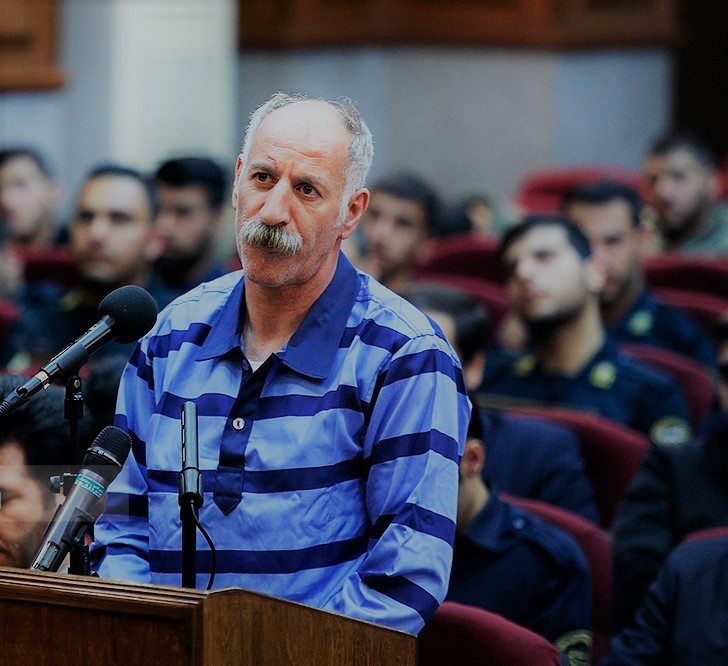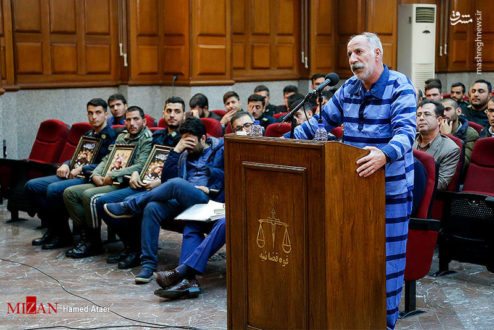kianetasavof -The three trial sessions of Mr. Mohammadiya Salas – The alleged driver of the “crazy bus” on the evening of 19th February 2018 in Pasdaran Avenue, Tehran, were held in the 9th branch of the Tehran Penal Court, headed by Judge Mohammadi Kashkoli and in the presence of two high counsellors – Abbasi and Volkie – within the assembly hall of the penal courts of Tehran. The prosecutor’s office was charged with gaining indictment, and demanding retribution from the accused through the most severe punishment possible on the behalf of the families of the victims, known as Naja martyrs.


The judge in the case, without the defendant having an actual defence attorney, and through a great deal of haste, terminated the hearing in a short time by formally convicting the suspect and sentencing him to three murder verdicts.
However, these verdicts are invalid for a number of reasons. The following is a discussion on the lack of prosecutional evidence and the issuance of a verdict that is baseless, due to the lack of reconstruction of the scene of the alleged crime, and the lack of physical presentation of the vehicle involved (the bus), or the photograph and film in the court, and the lack of referral to experts and forensic scientists and the lack of presentation of fingerprints from the scene. All of which goes to show that accused is innocent based on physical and material evidential reasons.
All of these matters are important and necessary problems for the noble high judges of the country to study and thus overturn the verdict of the lower court and once again refer the case to the same branch of the criminal courts.
Reconstruction of crime scene based on the testimony of witnesses present at the scene of the incident:
The biggest reason for the innocence of Mr. Mohammadiyar Salas, is the evidence that supports another person being behind the wheel of the “crazy bus” and the responsible driver for killing three people affiliated with the military forces, all of which are presented in the following text.
Here, we present a part of a complete and unreleased collection of photographs and films from the “Crazy Bus”, which, was involved in a collision that killed three people and injured others, including testified testimony of objective eye witnesses present at the crime scene at the time of the incident.
The testimony of the witnesses present at the time of this tragic accident is documented in photographs from various angles of the bus, involved in the incident. These exceptional photos have not yet been published by any other source, and are for the first time being released by the “Legal Advisor to the World Conservation Centre for Kian Tasavof”. Eye witnesses to the incident testify that the “killer bus” was driven by a young driver with beard and moustache and full black hair – without any sign of balding. Which is in complete contrast to appearance of Mr Salas, and old bald man with white hair.

(Above) The photo of the driver of the “crazy bus”

Mr Salas (pictured above at the time of his trial)
The history of protesters complaining to the police for being overrun by police vehicles.
The running over people who are gathered in the streets during protests with vans and police cars by police forces in Tehran and in other cities, has a long history. Which unfortunately, due to the immunity of the perpetrators of such incidents from prosecution, are common. In particular the use of chaotic situations by plain clothed security forces known as ” Al-Nasir Balerab “has become one of the commonplace issues in Iran over the past few years, and because of the multitude of occurrence, it is neither novel nor undeniable. Several photos and videos of such incidents are available in databanks of both domestic and foreign news and media companies, including audio-visual evidence. However, the true intention of the driver of the “killer bus” was not known to anyone in the Golestan seventh district on the evening of 19th February. According to the testimony of the eye witnesses the driver of the bus was for some unknown reason hysterical, and did not control the bus or have the skill to do so.
From the reconstruction of the films taken at the scene of the incident, together with the testimony of objective eye witnesses, one can determine that the driver of the bus belonging to the “Transition Staff of the Revolutionary Guards”, was a young man, and the bus was transported to Tehran by some of the uniformed personnel of the Revolutionary Guards from Karaj. Furthermore, the bus was parked on one of the streets of the “Pasadaran neighborhood” – and was moved to near to the Naja (security) forces. The Naja forces, who were suddenly surprised by the manoeuvres of the “uncontrolled bus”, took shelter in the sidewalks on both sides of the street and walked to the street from the side of the street, and then fired bullets towards the body of the bus in the front of the general public. The bullets not only shattered the windows of the bus, but also pierced its body.

However, the fired bullets did not stopped the bus, and as a result, the bus accidentally crashed into the streets filled with Naja forces and severely injured them. Other forces also shot at a driver’s window to stop the bus. The marks of two bullets on the driver-side glass are visible.

But the driver, who is also likely to be injured, apparently gets up in order to get off from the passenger side of the bus. Right at this moment and at this point, several rounds are shot at him. These bullets pierce the entire front of the bus, next to the driver’s seat, like a piercing bolt.

Thus, it is certain that the driver of the bus, with a face and body full of bullets, was pulled out of the bus. The bus also comes to a stop when it hits certain obstacles.

Mr. Mohammadiyar Salas was not the driver of the “crazy bus”:
Since the bus was hit by more than 40 bullets, the bus occupants and especially its driver, must have been covered with bullet holes. This is despite the fact that Mr Mohammadiyar Salas does not even have a bullet hole or a sign of a bullet mark on his body.

The reason for this is that Mohammadiyar Salas was in a coma at a hospital when the “crazy bus” was bombarded with bullets by Naja policemen. Mr Mohammadiyar Salas’ coma and his transfer to the hospital was also due to the injuries he received, as result of an attack by a number of plainclothes security forces with batons and other weapons, which, according to the eye witnesses, resulted in Mr Salas’ loss of consciousness. It was in this condition that security forces transported Mr Salas and then tried to make him to confess and bear witness against himself!
The beating of Mr Salas and his coma from his injury, and his transportation to the hospital occurred two hours before the accident of the “crazy bus” with the agents of the Naja. Therefore, Mr Salas could not have played any role in the incident.
Why is Mr Salas, who was at the time rumoured to have died from the injuries he suffered from security forces, is accused of being the driver of the killer bus?
According to the judge of the case, Mr. Salas was the only person in the entire Sufi group present at the Pasdaran Avenue on the 19th of February until two hours before the accident, who held a license to drive a bus. Judge Mohammadi Kashkoli, instead of reconstructing the scene and the producing forensic evidence, simply connects the death of the victims to the fact that Mr Salas possessed a driving license for driving a bus. The reason for such shoddy evidence is that the court is not only illegitimate, but also it does not possess any legal reasons for accusing Mr Salas.
The lack of documentary evidence by the prosecutor to the judge of the court:
During the trial, Judge Mohammadi Keshkoli did not raise the issue of “Al-Qataleh” (Murder) objectively, and nor did he mention or present photos and films of “the killer bus”. There was also no discussion about the finger printing of the bus, in order to prove the identity of the driver of the bus.
Why was the prosecutor trying to obtain admission of guilt from the accused, but did not provide evidence for criminal convictions?
After the first hearing of the court, which was broadcast live on the radio and TV, Mr Salas denied all accusations and considered himself innocent. In response the prosecutor and the judge refused to submit the pictures of the “crazy bus” as evidence against Mr. Salas. The reason for this is that if a photo taken from the bus, was presented Mr. Salas would immediately become aware of the trickery of the court and would have exposed the prosecution’s tricks on live radio and TV.
The fact is that Mr. Salas and his friends were sleeping in a bus during the nights that the Sufis had gathered in Pasdaran Avenue, and they had in fact pulled out seats of the bus and replaced with beds and painted the sides of the bus. The photos of the bus, painted as a sleeping place, prove that the bus used by Mr Salas as sleeping quarters, was not the same as the “killer bus”, which was driven by a young man with black hair. As the “killer bus” was completely white with no paintings and was hit by dozens of bullets. Therefore, by presenting the photos of the “crazy bus” Mr Salas would have realised that the bus involved in the incident was different to the one he was sleeping in during the nights and thus he would realise that the bus he was accused of driving, was actually different bus altogether.



Conclusion:
The Judge and prosecutors and other officials in the judiciary and judicial agencies affiliated with the security agencies through a complex devious plan want to introduce Mr Salas as the driver of the killer bus, and thus associate Mr Salas and Sufis with terrorist type actions that are carried out by groups like ISIS, which are known for running down innocent people. In order to create this devious association and fearing that the truth would create scandalous reaction, they refused to produce photo and film evidence of the incident and carryout forensic reconstruction of the crime scene and provide fingerprints of the bus.
Accordingly, the verdict of the court in producing a guilty sentence for Mr. Mohammadiyar Salas has no legal basis and no legal value and cannot be applied. In the absence of any clear evidence proving the criminal offense of Mr. Mohammadiyar Salas, the issuance of a reprimand and the encouragement of the families of the victim to be part execution Mr Salas as from of retribution has no legal merit. In fact, by encouraging the involvement of families of the victims in the execution of Mr Salas, the court only manages to infect the hands of the families of the deceased with the deliberate murder of an innocent person. The case against Mr Salas is not only baseless in Islamic and jurisprudential law, but also is in complete contradiction of all internationally recognised human rights.
Headquarters of the Legal Experts of the World Assembly for the Protection of Kayan Tasavof
19th April 2018
 Shabtabnews In this dark night, I have lost my way – Arise from a corner, oh you the star of guidance.
Shabtabnews In this dark night, I have lost my way – Arise from a corner, oh you the star of guidance.



